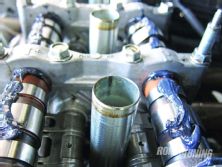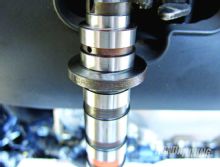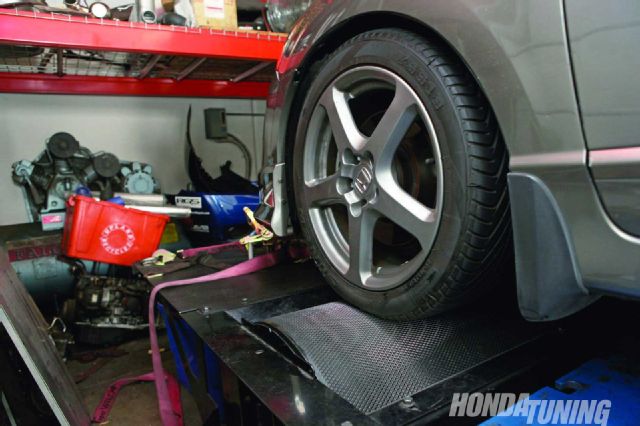 | Project Honda Civic Si Part 3: Dyno Tuning
| Project Honda Civic Si Part 3: Dyno Tuning
After the first round of bolt-ons, I had a few more parts on hand that I wanted to test for both power output and drivability. Somewhere between all of the parts starting to arrive and working out some sort of schedule to get everything installed, I spoke with Jeremy Lookofsky of Drag Cartel about cam options. Everyone should be familiar with the name, as Lookofsky is an industry giant, a living legend, and well-versed in all things race-related. However, he also has a good understanding of real-world daily drivers, and that’s where DC’s Drop-In-Cams come into play. The cams are unique in that they don’t require the use of aftermarket valvesprings or retainers. They simply “drop in” and you’re ready to hit the dyno. It’s a very smart move by DC, especially at a time when enthusiasts are looking for ways to increase power but aren’t in the financial position to purchase all of the extras required to run a big set of cams.
Also on the budget-minded side of things is Skunk2’s new Alpha Series header for the ’06–’10 Si coupe and sedan. I’d been wanting to test a header without a cat, like the one previously installed on the Si, and Skunk2’s seemed like a great candidate. Based on the wildly popular MegaPower header, the Alpha Series offers many of the same features and a very similar design, yet the price tag is incredibly low. Would this combo make power? I headed to Raceline USA’s dyno to find out.
On the Rollers
Elton Lo of Raceline is very familiar with Hondata, and has tuned more eighth gens than he can possibly remember. After a great tuning session with the initial bolt-ons, I was quite comfortable bringing the car back to him for another round of tuning. The first step was to strap the car on the dyno and get a baseline with the new Drag Cartel Drop-In-Cams.
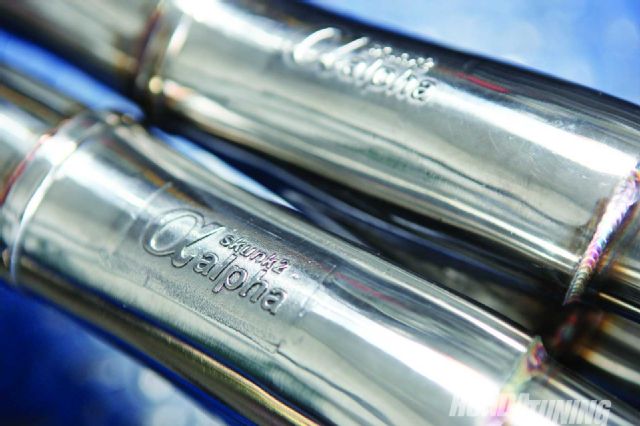 |
The Skunk2 Alpha Series header features an equal-length, tri-Y design in T304 stainless construction.
|
The Skunk2 Alpha Series header features an equal-length, tri-Y design in T304 stainless construction.
The initial baseline returned about the same power that I experienced at the end of the last tuning session, and we used that as the starting point. After multiple runs and Elton watching the air/fuel ratio like a hawk, he was able to pull an additional 9 whp out of the Drag Cartel cams! This is a substantial number from a set of mild street cams that don’t require aftermarket valvesprings or retainers. After a lunch break, we removed the cat-equipped header and installed the Skunk2 Alpha Series header. With more tuning, Elton was able to extract 4 additional wheel horsepower over the previous header. The tuning continued with the Skunk2 unit, and Elton eventually reached 215 whp. Though I could have ended the day with that peak number, Elton suggested backing off just a bit and running the car a little richer on the very top end for a safer setup. The cost for playing it safe is about 3 whp, but for the peace of mind, I’m extremely happy with the results. The Drag Cartel Drop-In-Cams and Skunk2 Alpha Series header make for an outstanding combo, while still relying on just a 2.5-inch exhaust system.
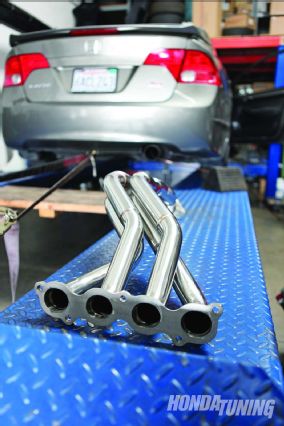 |
Thin-walled with a cast collector and 2.5-inch outlet, yet the price is incredibly low.
|
Thin-walled with a cast collector and 2.5-inch outlet, yet the price is incredibly low.
My Friend Made More Than That!
Dyno numbers are sometimes tricky little bastards. On one hand, you have a Dynojet, like Raceline’s, that measures power at the actual wheels, and on the other hand, you have Dynapacks that measure power at the hubs. The constant bickering about numbers being falsified, altered, etc. is never-ending. My concern is what power I leave with, as compared to what I arrived with on that particular day, and of course that pesky air/fuel ratio. That’s it. Could the car have made even more power? Absolutely. However, at the cost of reliability and longevity, it simply wasn’t worth it. Elton tunes a number of road race vehicles, including his own stable, and the ability to beat on the car session after session is vital. Personally, I want that same reliability on my street car.
 |
Elton Lo making some adjustments to the Hondata FlashPro.
|
Elton Lo making some adjustments to the Hondata FlashPro.
On the Road
With the new cams and header, a different note is apparent as soon as the car is started. The almost hollow, raspy bark from the throttle upon startup is music to my ears. On the street, power builds gradually with no loss of bottom end grunt, right up until the VTEC crossover, which is far more aggressive in both sound and feel. The car pulls hard all the way to redline and is begging for more headroom above 8,000 rpm. Wide-open throttle is indeed louder than before, but the newfound power is worth the added decibels.
Next up is a new throttle body and intake manifold to see if there are a few more horses to be squeezed out of the K20 in mild street form.
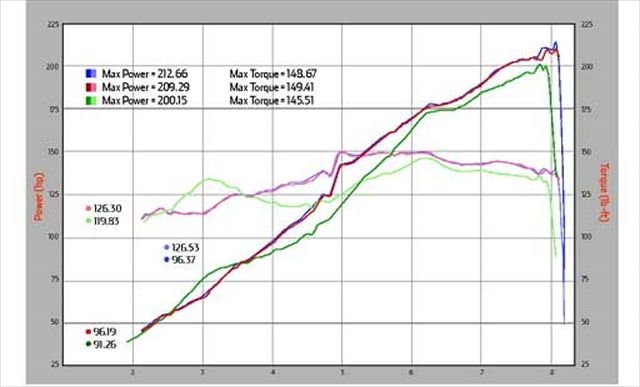 | Here you can see we experienced a slight loss of torque and horsepower between 2,500 and 3,500 rpm. However, immediately after that, things happen pretty quickly. The power jumps aggressively after 4,000 rpm and steadily climbs all the way to redline. A difference you can feel on every blast through the crossover.
| Here you can see we experienced a slight loss of torque and horsepower between 2,500 and 3,500 rpm. However, immediately after that, things happen pretty quickly. The power jumps aggressively after 4,000 rpm and steadily climbs all the way to redline. A difference you can feel on every blast through the crossover.


